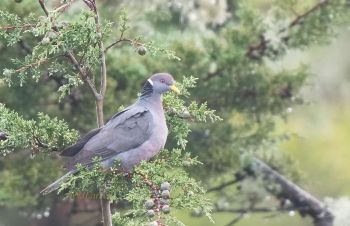- Patagioenas fasciata
Identification
34 to 36 cm (13.0-15.8 in)
- Grey overall
- Darker above
- Faintly pink head and underparts
- White belly
- Yellow bill and feet
- Green iridescence on the back of the neck
- Thin white collar on the nape
Juveniles lack the white nape cresent and have a scaly appearance, due to white feather edges on the upperparts.
Distribution
North America: Breeds along the pacific coast north to southern British Columbia, also southern Utah, western Colorado, Arizona, New Mexico and most of Mexico.
Central America: Reaches down to western or maybe even central Panama.
South America: Colombia and Venezuela to north-western Brazil, eastern Bolivia and northern Argentina.
Taxonomy
Subspecies
Clements recognizes seven subspecies[1].
- P. f. fasciata:
- Westeern North America from south-western Canada to Nicaragua
- P. f. letonai:
- Honduras and El Salvador (including Volcán de San Miguel)
- P. f. parva:
- Northern Nicaragua
- P. f. vioscae:
- Mountains of extreme southern Baja California (Sierra de la Laguna)
- P. f. crissalis:
- Costa Rica and western Panama
- P. f. roraimae:
- Tepuis of southern Venezuela (Mount Roraima)
- P. f. albilinea:
An 8th subspecies, P. f. monilis[2], is not recognised by all authorities
Habitat
Oak, pine-oak, and coniferous forests.
Behaviour
Breeding
One or two eggs are laid in a twiggy platform nest.
Diet
The diet includes seeds, notably acorns.
Vocalisation
Song is a slow series of deep, hooting, each rising slightly in pitch and recalling Long-eared Owl.
Movements
Pacific Northwest populations mostly migratory, wintering in California and Baja California. Some populations in the southwest move south to Mexico and Guatemala. Probably largely a diurnal migrant; large numbers occasionally observed on passage. Occasional vagrant to the East Coast.
References
- Clements, J. F., T. S. Schulenberg, M. J. Iliff, T. A. Fredericks, J. A. Gerbracht, D. Lepage, S. M. Billerman, B. L. Sullivan, and C. L. Wood. 2022. The eBird/Clements checklist of Birds of the World: v2022. Downloaded from https://www.birds.cornell.edu/clementschecklist/download/
- Gill, F, D Donsker, and P Rasmussen (Eds). 2023. IOC World Bird List (v 13.2). Doi 10.14344/IOC.ML.13.2. http://www.worldbirdnames.org/
- Wikipedia contributors. (2020, April 11). Band-tailed pigeon. In Wikipedia, The Free Encyclopedia. Retrieved 10:10, May 7, 2020, from https://en.wikipedia.org/w/index.php?title=Band-tailed_pigeon&oldid=950305878
- Keppie, D. M. and C. E. Braun (2020). Band-tailed Pigeon (Patagioenas fasciata), version 1.0. In Birds of the World (A. F. Poole and F. B. Gill, Editors). Cornell Lab of Ornithology, Ithaca, NY, USA. https://doi.org/10.2173/bow.batpig1.01
Recommended Citation
- BirdForum Opus contributors. (2025) Band-tailed Pigeon. In: BirdForum, the forum for wild birds and birding. Retrieved 11 May 2025 from https://www.birdforum.net/opus/Band-tailed_Pigeon
External Links
GSearch checked for 2020 platform.1






